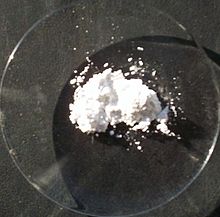Ytterbium(III) oxide
Appearance

| |
| Names | |
|---|---|
| IUPAC name
Ytterbium(III) oxide.
| |
| Other names
Ytterbia
diytterbium trioxide ytterbium sesquioxide | |
| Identifiers | |
| ChemSpider | |
| ECHA InfoCard | 100.013.850 |
| EC Number |
|
PubChem CID
|
|
| UNII | |
CompTox Dashboard (EPA)
|
|
| Properties | |
| Yb2O3 | |
| Molar mass | 394.08 g/mol |
| Appearance | White solid. |
| Density | 9.17 g/cm3, solid. |
| Melting point | 2,355 °C (4,271 °F; 2,628 K) |
| Boiling point | 4,070 °C (7,360 °F; 4,340 K) |
| Insoluble | |
| Structure | |
| Cubic | |
| Octahedral | |
| Thermochemistry | |
Std molar
entropy (S⦵298) |
133.05 J/mol·K [1] |
Std enthalpy of
formation (ΔfH⦵298) |
-1814.600 kJ/mol [1] |
Gibbs free energy (ΔfG⦵)
|
-1726.844 kJ/mol [1] |
| Hazards | |
| GHS labelling: | |

| |
| Warning | |
| H315, H319, H335 | |
| P261, P305+P351+P338[2] | |
| NFPA 704 (fire diamond) | |
| Flash point | Non-flammable. |
| Related compounds | |
Other anions
|
Ytterbium(III) sulfide, Ytterbium(III) chloride |
Other cations
|
Thulium(III) oxide Lutetium(III) oxide |
Except where otherwise noted, data are given for materials in their standard state (at 25 °C [77 °F], 100 kPa).
| |
Ytterbium(III) oxide is the chemical compound with the formula Yb2O3. It is one of the more commonly encountered compounds of ytterbium. It has the "rare-earth C-type sesquioxide" structure which is related to the fluorite structure with one quarter of the anions removed, leading to ytterbium atoms in two different six coordinate (non-octahedral) environments.[3]
Uses
See also
References
- ^ a b c R. Robie, B. Hemingway, and J. Fisher, “Thermodynamic Properties of Minerals and Related Substances at 298.15K and 1bar Pressure and at Higher Temperatures,” US Geol. Surv., vol. 1452, 1978.[1]
- ^ Sigma Aldrich; rev. 2012-09-19
- ^ Wells A.F. (1984) Structural Inorganic Chemistry 5th edition Oxford Science Publications ISBN 0-19-855370-6

